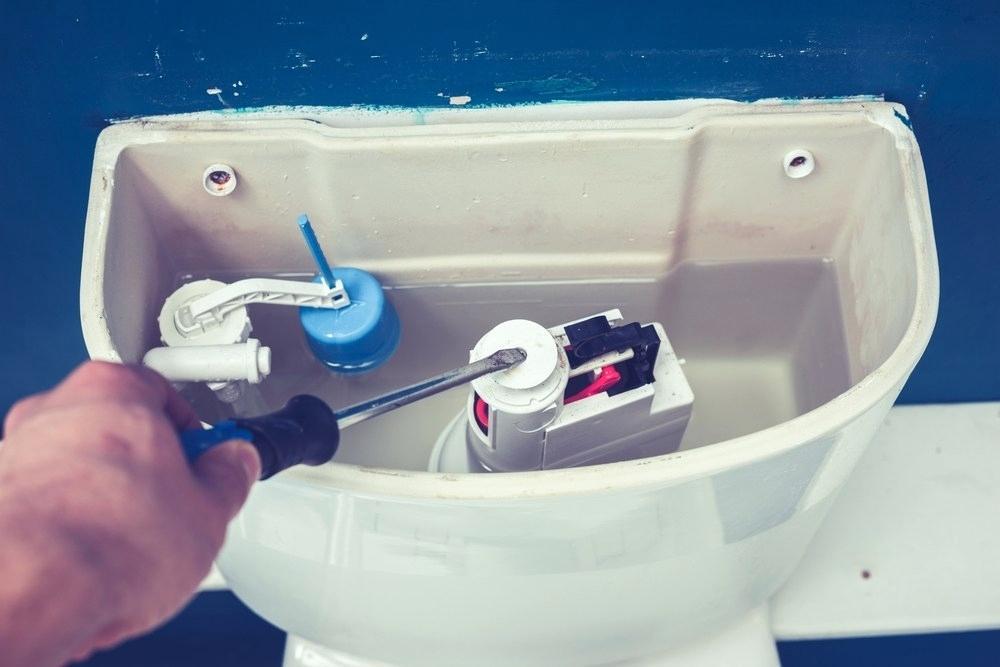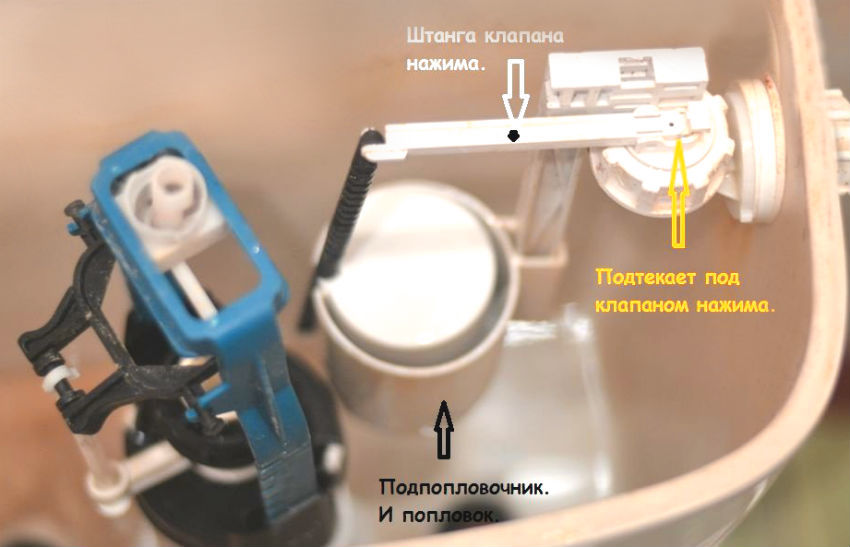Any toilet malfunction causes many problems. This is especially true of the tank - the most important and structurally complex element of the system. Read on for the reasons for leaks, slow filling, ways to eliminate them and prevent such episodes.
Why is the toilet cistern leaking?
The content of the article
- Why is the toilet cistern leaking?
- What to do if the tank is leaking
- What to do if a toilet cistern with a flush button is leaking
- Preventive measures
Consider the problems that cause the tank to leak when it lets water down the toilet.
Common capacity overflow occurs most frequently. Here, the excess volume of liquid is simply drained into the overflow opening. A malfunction can occur in the following cases:
- the float is in the wrong position;
- the valve stud holding the displacer has failed after a long service due to corrosion;
- the valve body is cracked - water is oozing through this damage;
- the gasket has lost its elasticity and deformed during operation;
- the seal is of high quality, retained its properties, but there is a small gap between it and the outlet due to loose contact.

The second source of trouble is the bolts that secure the tank to the toilet. Metal clips rust over time, plastic counterparts can burst. Loose contact may be an option.
The third case is associated with a pear that has lost its elasticity. As a result, it has an irregular shape after a long service life.
The fourth situation is a skew or a noticeable displacement of the lever associated with the displacer. The part could move after prolonged use, or the reason lies in the low quality of the float: a gap sometimes forms in it through which water oozes.
The fifth type of problem occurs between the toilet and the tank. It indicates a loss of cuff tightness.
The sixth malfunction lies in the shut-off valve.
The seventh defect is caused by cracks on the sides or at the bottom of the container.
What to do if the tank is leaking
We carry out a certain sequence of actions. It consists in the fact that you should first diagnose the source of the malfunction, and then eliminate it.
Remove the tank lid. Raise the float element up by hand. If the problem lies in it, the flow will stop immediately. This means that the displacer arm is at the wrong angle and cannot block the leak.
To restore the performance of the part, we will slightly adjust the lever. When the water reaches a certain level, it will begin to block its flow.
If the water is still running, we examine the valve for external damage to the stud. Located inside the shutter, the device controls the valve circuit, stopping its operation at the right time. Additionally, we look at the state of the opening in which the hairpin is located - it should be without deformations.
The defect can be corrected by changing the hairpin to a copper wire of identical diameter. The hole problem is solved by installing a new shutter.
Pay attention to the cuff for wear or clearance between it and the valve.
We press the part more tightly to the valve, and if the flow has stopped, we need to restore the weakened contact. If the adjustment doesn't help, just change the gasket.
Let's examine the bolts connecting the tank to the toilet. In cases where at least one of them is rusted, we recommend completely replacing the kit so that after a while you do not have to do this repair again. Whether to change both plastic clips - decide for yourself. Look at the bolt that remains intact: if it has no visible violations, then it can serve for a long time.
We tighten the fasteners that are loose with a wrench and screwdriver.
Attention! Be careful when screwing in parts: ceramics is a brittle material, it cracks from excessive pressure.
Let's make sure that the pear has kept its shape.
This element is not amenable to repair work; in the event of a defect found, you will have to buy a new part.
Examine the float. If there is a hole in it, you can close it with a piece of polyethylene or a heated piece of plastic. However, this is a temporary measure, it is better to change the product to a higher quality analogue.
Next, we will deal with the seal between the toilet and the cistern. A gasket that has lost functionality will require replacement.
Reference! Buy the softest to the touch, it will last longer before it gets stiff.
Let's work with the drain valve. It can be disassembled, the pressure on the drain tube can be adjusted by slightly cutting the end. However, these procedures will take a lot of time, effort and do not always give the desired result. The optimal solution here is to buy a new node.
Let's examine the tank for cracks.
To correct the identified defects, remove the cistern from the toilet and leave it to dry completely. We carefully process all chips with high quality sealant and wait for the seams to dry.
Attention! When renovating, we follow the principle "from simple to complex": first we correct elementary flaws, then we eliminate more serious flaws.
What to do if a toilet cistern with a flush button is leaking
The cause of the problem is often the failure of the return spring, which ensures the operation of the switch. The circuit in such situations is constantly in the "open" position, and the water will continuously ooze.
To fix the problem, we will perform a number of manipulations:
- remove the toilet lid;
- we extract the sinking push-button mechanism;
- we replace the spring;
- we check that the place for planting the system is strictly in the center, right under the hole in the cover;
- we carry out the installation in the reverse order.

Preventive measures
These measures will help to avoid unnecessary problems and ensure the smooth functioning of the plumbing:
- once every six months, we completely clean the tank and toilet bowl from rust and accumulated deposits;
- we regularly monitor the condition of the reinforcement, we control the correct position of all elements;
- we observe a constant temperature in the bathroom, because its jumps can harm the details;
- we exclude any mechanical damage to the device.
Repairing the tank in the event of leaks is usually not difficult. If you follow the above methods, then all actions are carried out in the shortest possible time, with the least expenditure of time and effort. Often, the units require complete replacement, but in simple cases, repairs are carried out to ensure long-term and stable operation of the device. It is important to regularly carry out preventive maintenance - this will significantly increase the operational life.


